Pre-empting the Strawberry milkshake
#21
Registered User
Join Date: May 2007
Location: Denver metro area-CO
Posts: 2,175
Likes: 0
Received 2 Likes
on
2 Posts
Our Denver area event is still slated for Sunday, June 27 for a 3rd gen maintenance and repair day.
We'd love to have a guest "expert" on site. Gives you time to pack up the Runner and come on down...
We'd love to have a guest "expert" on site. Gives you time to pack up the Runner and come on down...
#22
Contributing Member
iTrader: (1)
Not sure if you've seen this thread, but there's some decent information there about transmission temperature gauges.
https://www.yotatech.com/forums/f2/l...ations-200621/
Also some discussion of the inline filters if you are interested.
I'm curious to see your flushing process and what you figure out for a temp. gauge. Unfortunately it seems that the ScanGauge II doesn't work with the earlier year 3rd gens. Keep up the good work!
https://www.yotatech.com/forums/f2/l...ations-200621/
Also some discussion of the inline filters if you are interested.
I'm curious to see your flushing process and what you figure out for a temp. gauge. Unfortunately it seems that the ScanGauge II doesn't work with the earlier year 3rd gens. Keep up the good work!
#23
Thanks, as you can see I have the coolers installed but I still need to plumb everything into them. I don't want to actually tie them together until I can monitor the temp prior to switching over. Trying to find the best gauge along with determining the best location for the gauge is the primary holdup right now. Have been considering a couple of gauges right now and would like to use one of the A pillar pods, but trying to find one that will FIT my 4runner is the issue right now. I want it to look correct and not like some after thought add-on. Gr8 link by the way, thanks!
#24
Registered User
Just another piece of info: my stepdad has a 2005 Tundra 4x4, and when I was looking under the hood the other day, I noticed he had a factory external tranny cooler mounted in front of his radiator, sans additional fan.
#25
Registered User
Join Date: Mar 2006
Location: Orlando, FL
Posts: 208
Likes: 0
Received 0 Likes
on
0 Posts
Two coolers seem like a bit of overkill to me and add more opportunities for fittings to leak or fail. I'm wary of an in-line filter too since it would seemingly restrict flow more so than the stock wire mesh filter (and add even more fittings to leak or fail). The way you have the coolers mounted will not allow them to reap much benefit of the stock fan since there is such a large gap for air to flow around rather than through the coolers (path of least resistance). Save yourself some trouble and just install one cooler without a fan and see if that keeps the temps low enough when operated in your worst-case scenario. If not, add the fan. If still too hot then add the other cooler. I'm guessin' you will be fine doing what most of us do - just running one cooler without an aux fan.
#26
Two coolers seem like a bit of overkill to me and add more opportunities for fittings to leak or fail. I'm wary of an in-line filter too since it would seemingly restrict flow more so than the stock wire mesh filter (and add even more fittings to leak or fail). The way you have the coolers mounted will not allow them to reap much benefit of the stock fan since there is such a large gap for air to flow around rather than through the coolers (path of least resistance). Save yourself some trouble and just install one cooler without a fan and see if that keeps the temps low enough when operated in your worst-case scenario. If not, add the fan. If still too hot then add the other cooler. I'm guessin' you will be fine doing what most of us do - just running one cooler without an aux fan.

As for the transmission filter, if you use the correct spin on filter designed for use with transmission fluid with the correct bypass valve structure you can actually extend the life of both the fluid and the transmission due to actual filtering of the fluid. To prevent the filter from clogging you once again need to adhere to a standard maintenance schedule. But seeing how practically all non-commercial vehicles out there with an automatic transmission (a.k.a. 4runners) does not use any filter except the internal one, the changes of clogging a spin on tranny filter are very negligable. Another side benefit of most transmission filter kits is the filter boss usually have 3 ports, inlet, outlet and a third tap for installation of a temperature monitoring probe.

The one in your transmission only helps to prevent large pieces of transmission debris from entering your valve body components which would lead to component failure or worse. This internal screen does nothing for the fluid itself. The only time you really need to change your internal tranny filter is if you:
1) fry your transmission and require a rebuild,
2) failure/slippage of the transmission during operation which could result in pieces of clutch material to flake off and then become trapped in valve body ports resulting in further issue or catastropic failure. (see #1)
Normal wear and tear on the transmission internal components is not taken care of by the internal "filter" it is just a screen. For the most part, this is not seen as a major issue by most transmission manufacturers so they have opted out of any reason to install some sort of preventative piece of equipment.
 As for leaks, it you due caution and standard shop practices when fitting and attaching the components you should have a solid install with mini9mal chance for leakage. Just like changing your own oil and filter, use established shop practices, a checklist (so you don't forget something like the drain plug), proper tools and torque settings and you should have no issues. Hey I do understand about the more pieces to the plumbing the more places to have a leak! I am going slowly and methodically, thanks for the input.
As for leaks, it you due caution and standard shop practices when fitting and attaching the components you should have a solid install with mini9mal chance for leakage. Just like changing your own oil and filter, use established shop practices, a checklist (so you don't forget something like the drain plug), proper tools and torque settings and you should have no issues. Hey I do understand about the more pieces to the plumbing the more places to have a leak! I am going slowly and methodically, thanks for the input.
#27
Registered User
Join Date: Mar 2006
Location: Orlando, FL
Posts: 208
Likes: 0
Received 0 Likes
on
0 Posts
As for the transmission filter, if you use the correct spin on filter designed for use with transmission fluid with the correct bypass valve structure you can actually extend the life of both the fluid and the transmission due to actual filtering of the fluid. To prevent the filter from clogging you once again need to adhere to a standard maintenance schedule. But seeing how practically all non-commercial vehicles out there with an automatic transmission (a.k.a. 4runners) does not use any filter except the internal one, the changes of clogging a spin on tranny filter are very negligable. Another side benefit of most transmission filter kits is the filter boss usually have 3 ports, inlet, outlet and a third tap for installation of a temperature monitoring probe.
The one in your transmission only helps to prevent large pieces of transmission debris from entering your valve body components which would lead to component failure or worse. This internal screen does nothing for the fluid itself. The only time you really need to change your internal tranny filter is if you:
1) fry your transmission and require a rebuild,
2) failure/slippage of the transmission during operation which could result in pieces of clutch material to flake off and then become trapped in valve body ports resulting in further issue or catastropic failure. (see #1)
Normal wear and tear on the transmission internal components is not taken care of by the internal "filter" it is just a screen. For the most part, this is not seen as a major issue by most transmission manufacturers so they have opted out of any reason to install some sort of preventative piece of equipment.

The one in your transmission only helps to prevent large pieces of transmission debris from entering your valve body components which would lead to component failure or worse. This internal screen does nothing for the fluid itself. The only time you really need to change your internal tranny filter is if you:
1) fry your transmission and require a rebuild,
2) failure/slippage of the transmission during operation which could result in pieces of clutch material to flake off and then become trapped in valve body ports resulting in further issue or catastropic failure. (see #1)
Normal wear and tear on the transmission internal components is not taken care of by the internal "filter" it is just a screen. For the most part, this is not seen as a major issue by most transmission manufacturers so they have opted out of any reason to install some sort of preventative piece of equipment.
#28
I was able to avert the strawberry milkshake this weekend by putting in my new koyo radiator and rerouting my hayden. I was afraid of it not cooling sufficiently but time will tell i suppose. Also the ratings on my hayden (1678 model) says it should be sufficient. I did not install a temp gauge so I will not be able to monitor it. I guess I'm putting a lot of faith into it. I don't do much offroading and towing but my main concern was sitting in 100 degree traffic.
#30
Registered User
Join Date: Jun 2010
Location: ontario,Canada
Posts: 14
Likes: 0
Received 0 Likes
on
0 Posts
Yeah I was woundering about the same thing. I know that i will be putting on a cooler. I was already forced to put in a new rad on my 99' SR5. I got to watch the drip,drip,drip gush of strawberry milk shake come outta my trani. So i'm in the market to find another trani and was woundering about wich one of the years of A340F's i could use? Mine is befor they started offering the multimatic later in the production year.
#31
Radiator replacement is really simple to do yourself. All you need is a couple of sockets, ratchet, extention, channel lock pliers and a small flat tip screw driver.
Pull the grill (small flat tip screwdriver),
drain radiator,
remove the clamps to the upper and lower hose (channel lock pliers),
remove the hoses from radiator,
remove four bolts from inside engine bay holding fan shroud (10 mm),
remove the 4 bolts from the front side of the radiator (12 mm & that's why you removed the grille) which hold the side rails then push the fan shroud cover over a little bit and pull the radiator out.
Reverse the procedure and replace with new radiator hoses and you're going to be good to go.
Make sure after you pour in the new coolant, start the car with the radiator cap off and have the heater full blast. leave the radiator cap off and let the bubbles come up to clear any air in the system and add coolant as needed. after 10-15 mins and when the car is warmed up and no more bubbles are coming up in radiator, put the radiator cap on and you should be good to go. make sure the resivor tank is at the proper level too. test drive around for 10 mins and come back to see if there is any leaks. if not then your good.
also make sure when you pull the lines for the transmission that you watch for losing some fluid. when i added my tranny cooler years ago i did not lose much so i didnt have to add any back in but this time for some reason i lost a lot of fluid. lucky after i finished i was able to drive to the dealership (3 miles away) and get some. if you are adding a transmission cooler just remember you will probably need about 8 feet of 3/8ths tranny cooler line. you probably can get away with less depending on how you route it but i'd rather have too much then too little. you can always cut more off if the lines are too long. i used this write up to help with the install but you only need it to figure out the send and return lines.
https://www.yotatech.com/forums/f128...4runner-76336/
basically you just connect the send line to one end of the aftermarket tranny cooler and then connect the other end to the return line. so your radiator's send and return lines will not be connected to anything. you can connect them to close the loop incase if ever bursts per mtn goats idea.
shoot me a PM if you have any questions or find me on AIM. CLin9383. good luck
#32
Registered User
Join Date: May 2007
Location: Denver metro area-CO
Posts: 2,175
Likes: 0
Received 2 Likes
on
2 Posts
CLin 9383 that is really helpful step by step I appreciate that sir. We are not doing the tranny cooler just replacing the radiator is the method we chose to head off the problem before it occurs.
yoda toyota I see you now sir thanks for the private message. I do think there were changes in the auto tranny over the years but I am not 100% sure. I am not positive that you could use any 96 through 02 auto tranny to fill your needs. Best to double check that with an independent shop or Yota dealership to be sure.
yoda toyota I see you now sir thanks for the private message. I do think there were changes in the auto tranny over the years but I am not 100% sure. I am not positive that you could use any 96 through 02 auto tranny to fill your needs. Best to double check that with an independent shop or Yota dealership to be sure.
#33
Registered User
Join Date: Jun 2010
Location: ontario,Canada
Posts: 14
Likes: 0
Received 0 Likes
on
0 Posts
Thanks Ron.
Yeah I'm still fishin around for a trani. I was given such a broad time line on when the bleedin thing could go. From a month to never. I was in boy scouts and the moto is Be prepared. Thats what I'm trying to do so we are not caught flat footed in a rush to be finding one. Amazing sight though watchin the thing gush over like that. Makes you say " wow" and wanna cry all at the same time.
Yeah I'm still fishin around for a trani. I was given such a broad time line on when the bleedin thing could go. From a month to never. I was in boy scouts and the moto is Be prepared. Thats what I'm trying to do so we are not caught flat footed in a rush to be finding one. Amazing sight though watchin the thing gush over like that. Makes you say " wow" and wanna cry all at the same time.
#34
Tranny Gauge Sensor Location
Been investigating the location for installing the tap for the tranny temp guage to monitor the temperature the most acurately. Went to a localy transmission service shop and asked them about the tranny cooler and installing a monitoring gauge. They recommended installing the boss directly in the transmission pan. They said they have done this many times and it requires they tig weld the boss into the pan. Only requires another 1/2 hour labor to install the boss as they have the pan off for the tranny service. The cost to do a service (filter and fluid change) for my 4runner is supposed to be $110. Another $45 to install the boss. Might go this route.
What have others done as far as the location of the sensor? How and where have you installed the gauge sensor? Would be nice to have this installed and operational before my trip to SoCal. thanks guys
What have others done as far as the location of the sensor? How and where have you installed the gauge sensor? Would be nice to have this installed and operational before my trip to SoCal. thanks guys

Last edited by Ritzy4Runner; 06-21-2010 at 10:06 AM. Reason: spelling
#35
Contributing Member
Personally I wouldn't want my sensor to monitor the pan temp. That would be the coolest ATF in the system. I'd try to get it to monitor the hottest ATF myself (on the way to the cooler).
The simplest way is to cut the rubber cooler line and put the sensor in a block of some kind.

Make sure the sensor doesn't block flow too much.

Be aware some sensors only have 1 wire and require a ground of some kind (might have to add a ground wire to the block).
The simplest way is to cut the rubber cooler line and put the sensor in a block of some kind.

Make sure the sensor doesn't block flow too much.

Be aware some sensors only have 1 wire and require a ground of some kind (might have to add a ground wire to the block).
Last edited by mt_goat; 06-21-2010 at 10:31 AM.
#36
Thanks Dale, was wondering about that. So what we really want it the temp going OUT of the tranny where as the pan mounted boss would be where the return oil is BEFORE it gets sucked up into the tranny, correct?
So the best place for this would seem to be right after the hard line from the tranny to the rubber hose to the cooler? Seems to make sense and would be alot cheaper!
So the best place for this would seem to be right after the hard line from the tranny to the rubber hose to the cooler? Seems to make sense and would be alot cheaper!

#37
MTGoat, been looking for fitings like you are showing and not having very much sucess finding what I need. what size are the fittings you used? I have contrmplated using two gauges just for a real world monitor, one for inlet one for outlet. Still looking at gauges and mounting but I need the fittings before I install anything and also the best gauges to install that aren't $50 a piece! Any info on sizes qould be huge, thanks Dale!
#38
Contributing Member
MTGoat, been looking for fitings like you are showing and not having very much sucess finding what I need. what size are the fittings you used? I have contrmplated using two gauges just for a real world monitor, one for inlet one for outlet. Still looking at gauges and mounting but I need the fittings before I install anything and also the best gauges to install that aren't $50 a piece! Any info on sizes qould be huge, thanks Dale!
Last edited by mt_goat; 06-29-2010 at 03:24 AM.
#39
I updated the post with some of the basics for the new "T". Check first post as I put some of the pics there.

I bought the Sun Pro Style Line series gauge kit (triple) which has 3 gauges, temp, volt meter and oil pressure. As I wanted to monitor both inlet and outlet transmission temps I purchased the identical single temp gauge kit as well.
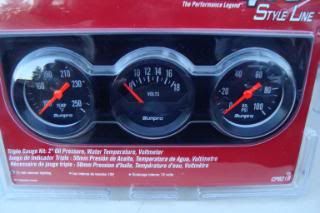
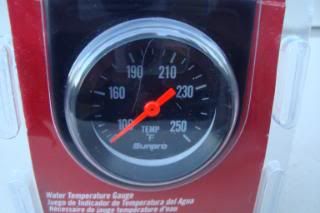
Took the single gauge with me to Home Depot and used it to find the parts I needed so the sensor tip would be in the flow but high enough to not block or impede the flow as Mt_Goat recommended. The completed assembly
The completed assembly

NOtice the tip of the sensor is visible and will sense the temp of the passing fluid.
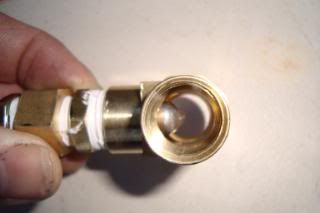
I was not able to find the same type of fittings as Mt_Goat used but they are basically the same. The key is to get fittings to match the gauge set you are using. I used the pipe bushing to extend the sensor higher in the 'T' to give it the correct height. It worked out perfect as the bushing was the perfect diameter to let the sensor pass through.

This bushing allowed me to also then install the provided adapter to give the perfect height. This fitting supplied with the gauge kit is also a flaired fitting to provide a seal for the sensor when it is secured into the adapter
Now my question ito all who are watching this thread or just now reading it, I will have three gauges, 2 temp for inlet and outlet temp. Of the two remaining gauges, which should I install (volt or oil press) Which one would you feel the most need to have? Iknow it is a preference but which would you put in your vehicle?
Here I have set up the gauge cluster with the two temps and left the voltmeter installed. I know its not the best to be bringing REAL oil into the cab, but I did it in older vehicles with no issues but just wanted to get everyones suggestions.
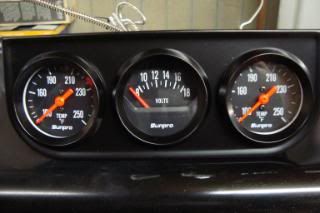
I also decided on putting the gauge cluster below the 12VDC outlet and the ashtray. I just did a preliminary fitup to see if it would be fesible and it does and there is enough room for the gauges to be mounted. Using the angle of the pre-formed plastic of the 12vdc socket, it angles the gauges up for a better view. fitment will leave about a 1/2" gap at the base but will not be that noticable once installed. This way I won't have to modify the cubby by cutting anything just yet. After I get it all set up and functioning, I'll look at modifing the install
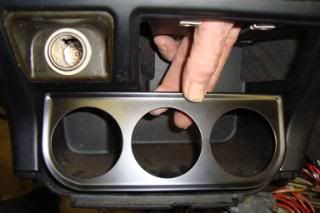


I bought the Sun Pro Style Line series gauge kit (triple) which has 3 gauges, temp, volt meter and oil pressure. As I wanted to monitor both inlet and outlet transmission temps I purchased the identical single temp gauge kit as well.


Took the single gauge with me to Home Depot and used it to find the parts I needed so the sensor tip would be in the flow but high enough to not block or impede the flow as Mt_Goat recommended.
 The completed assembly
The completed assembly
NOtice the tip of the sensor is visible and will sense the temp of the passing fluid.

I was not able to find the same type of fittings as Mt_Goat used but they are basically the same. The key is to get fittings to match the gauge set you are using. I used the pipe bushing to extend the sensor higher in the 'T' to give it the correct height. It worked out perfect as the bushing was the perfect diameter to let the sensor pass through.

This bushing allowed me to also then install the provided adapter to give the perfect height. This fitting supplied with the gauge kit is also a flaired fitting to provide a seal for the sensor when it is secured into the adapter
Now my question ito all who are watching this thread or just now reading it, I will have three gauges, 2 temp for inlet and outlet temp. Of the two remaining gauges, which should I install (volt or oil press) Which one would you feel the most need to have? Iknow it is a preference but which would you put in your vehicle?
Here I have set up the gauge cluster with the two temps and left the voltmeter installed. I know its not the best to be bringing REAL oil into the cab, but I did it in older vehicles with no issues but just wanted to get everyones suggestions.

I also decided on putting the gauge cluster below the 12VDC outlet and the ashtray. I just did a preliminary fitup to see if it would be fesible and it does and there is enough room for the gauges to be mounted. Using the angle of the pre-formed plastic of the 12vdc socket, it angles the gauges up for a better view. fitment will leave about a 1/2" gap at the base but will not be that noticable once installed. This way I won't have to modify the cubby by cutting anything just yet. After I get it all set up and functioning, I'll look at modifing the install


#40
Registered User
Join Date: May 2009
Location: Hawaii
Posts: 181
Likes: 0
Received 0 Likes
on
0 Posts
Very interesting and informative thread Ritzy!
About your gauges-if I were you, I would definitely put in the oil pressure gauge instead of the volt gauge. If you have a scangauge, you can monitor the volts from that.
One thing that puzzles me about the 4Runner is why Toyota decided not to put in an oil pressure gauge from the factory when they did with the T-100 which basically has the same drive train...not really a big deal but I am the kind of person who likes to have the ability to monitor my vehicle and prevent a possibly big problem from happening.
About your gauges-if I were you, I would definitely put in the oil pressure gauge instead of the volt gauge. If you have a scangauge, you can monitor the volts from that.
One thing that puzzles me about the 4Runner is why Toyota decided not to put in an oil pressure gauge from the factory when they did with the T-100 which basically has the same drive train...not really a big deal but I am the kind of person who likes to have the ability to monitor my vehicle and prevent a possibly big problem from happening.








